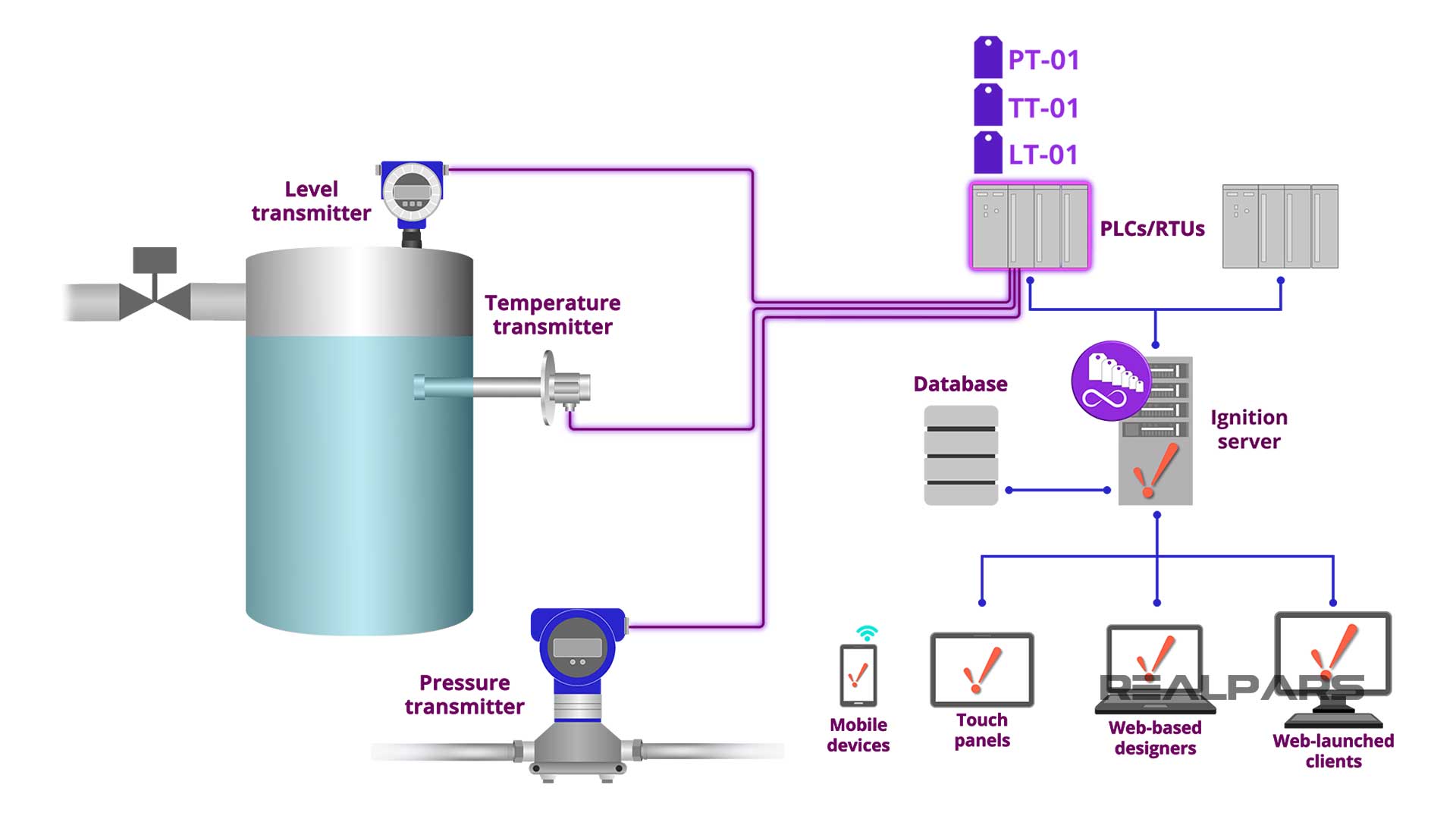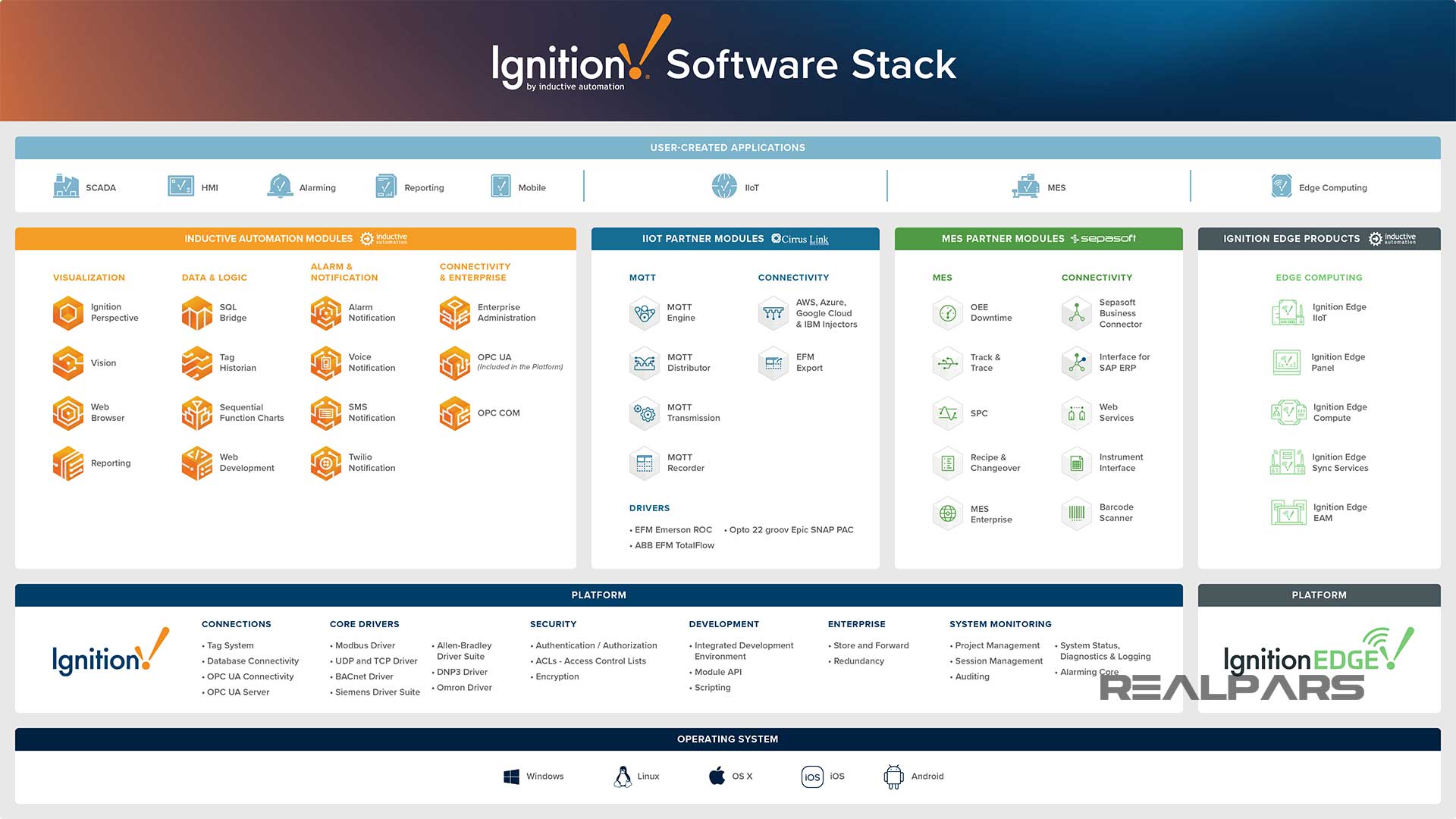Introduction to Ignition SCADA


In this article, we’re going to talk about a SCADA software called Ignition by Inductive Automation. We’ll learn what Ignition is and what makes it unique from other SCADA software applications. Then, we’ll dive into how the Ignition SCADA platform works by going over its core modules so that you’ll have a basic knowledge before getting started on your first Ignition project.
What is SCADA?
As you’ll quickly learn with any engineering application, we live in a world of acronyms. In industrial automation, SCADA stands for Supervisory Control And Data Acquisition.
As industrial automation professionals, we use SCADA to integrate as much of an engineering process in a plant or facility as possible into one easy-to-use software interface.
This software interface is used to control the process, alert operators and managers of problem situations and gather useful information along the way.
Overview of Ignition SCADA
What is Ignition?
First, let’s talk about what Ignition is. Inductive Automation first released its Ignition SCADA software in January 2010.
Since then, it has gained tremendous popularity among industrial automation professionals. Ignition is known for powerful and modern graphical objects, its web-based architecture, its unlimited licensing structure, and its developer-friendly tools.

What makes Ignition SCADA unique?
Ignition is an IT and network-based software. As an automation professional, a working IT knowledge base is becoming virtually a requirement for modern industrial applications.

Ignition is what is called cross-platform. This means that it can be used on most standard computer operating platforms such as MAC OS X, Windows, and Linux distributions.

Ignition is also able to handle many standard external devices and databases.

Ignition uses an unlimited licensing structure. There is no limit to the number of tags, screens, or client applications used to build a project.
There is also no limit on the number of engineers that can use the development tool. This detail has engineers, operators, and owners excited about the software.
Ignition’s application development tool is called Ignition Designer. Designer has modern graphical objects built-in and utilizes a popular and powerful programming language called Python for their native scripting.

Scripting is used in SCADA applications to customize elements of the application when a need is not native to the SCADA software.
Python is an open-source object-oriented programming language that is among the most widely used programming languages today.
Now that we’ve learned what makes Ignition unique, let’s dive into how Ignition works by talking about Ignition modules.
How does Ignition work? (Modules)
Ignition SCADA software is built and sold by modules.

Platform module
There are a couple of Ignition modules that are essential. The first is called Ignition Platform. This module includes tags, designer clients, and drivers that allow you to connect to necessary devices and databases, such as PLCs and SQL databases.

In this section, we’ll cover Ignition’s core modules. Then we’ll mention some of their more advanced and even third-party modules.
An OPC UA Server module is also included with this module. OPC UA stands for Open Platform Communications United Architecture. It is a standard industrial communication protocol that allows different devices to communicate together.

Tags and databases are the backbones of a SCADA operation.
For example, let’s think of a plant floor tank fitted with level, temperature, or pressure transmitters. Those transmitters send a raw data signal back to the PLC which may have some form of scaling or other logical manipulation and is stored as a tag.
This tag is what ends up being used and displayed in a SCADA application. Depending on your industrial application, you can have hundreds or even thousands of tags or database points.

Vision and perspective modules
The next essential Ignition module is in the visualization category. One of SCADA’s main functions is to visually display important plant operations and data in a graphical user interface.
This interface can belong on an HMI out on the plant floor, on several monitors in a control room, on an engineer’s laptop, or even a smartphone.

Ignition has two options for this. There is the Vision module or the Perspective module.
The Vision module is Ignition’s classic visualization software that they have been supporting for many years. This module is designed to be used on desktop screens and traditional plant floor HMIs.
The Perspective module is Ignition’s new and modern approach to visualization software. It is fully web-based which will allow you to launch your industrial application from anywhere on a web browser so long as you’re safely connected to the plant network.
Because of how it’s designed, Perspective can be used on mobile devices such as tablets and smartphones.
You can also use what is called kiosk mode for a more traditional feel that works well with control room monitors and plant floor HMIs. If you’re interested in Ignition’s most current and modern software, Perspective is the way to go.

Alarm Notification, Tag Historian, Reporting Modules
Other important modules include the Alarm Notification module, the Tag Historian module, and the Reporting module.

Alarms and notifications are essential to a healthy industrial plant or facility. As automation professionals, we use them to alert operators, engineers, managers, and owners alike of any abnormal or catastrophic situations to the engineering process.
You can use Ignition’s Alarm Notification to set up alarms and notifications on the local application, and/or via email, phone call, or SMS text message.

Reporting in SCADA is a little different than alarming. We habitually use reports to relay a given set of information about the plant or process to relevant plant personnel.
You can use Ignition’s Reporting module to automatically generate and send data in a PDF format.
Oftentimes, it is important to take a look into the past to troubleshoot issues at a plant. In SCADA this is done by logging tag data into a database.
We can use this data to set up graphical trends of historical data. This makes Ignition’s Tag Historian module an important one to use. You can use this historical data together with a visualization module or reporting module to stay on top of your industrial application.

Partner and third-party modules
We’ve covered the core modules that make Ignition SCADA work. There are several other native Ignition modules, partner modules to achieve advanced project-specific goals, and even third-party modules developed by Ignition users like you and me.

Take a look at this full module layout.

Summary
Alright, let’s summarize what we learned today.
– We reviewed what SCADA means and how it is used in industrial applications.
– We then learned what Ignition SCADA is and what makes it unique from some other SCADA software.
– After that, we took a deeper dive into how Ignition works to achieve modern SCADA with its use of native, partner, and third-party modules.
For more details about SCADA, check out some of our other articles on the subject:
– What are the differences between DCS and SCADA?
– SCADA application in water treatment
– What is the difference between SCADA and HMI?
Please let us know if you have any questions about Ignition SCADA, or about SCADA in general, add them in the comments below and we will get back to you in less than 24 hours.
Got a friend, client, or colleague who could use some of this information? Please share this article.
Learn from
industry experts
with a free 7-day trial, then $25/month


